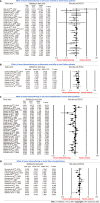Telemonitoring in heart failure patients: Systematic review and meta-analysis of randomized controlled trials
- PMID: 36605424
- PMCID: PMC9808028
- DOI: 10.4330/wjc.v14.i12.640
Telemonitoring in heart failure patients: Systematic review and meta-analysis of randomized controlled trials
Abstract
Background: Home telemonitoring has been used as a modality to prevent readmission and improve outcomes for patients with heart failure. However, studies have produced conflicting outcomes over the years.
Aim: To determine the aggregate effect of telemonitoring on all-cause mortality, heart failure-related mortality, all-cause hospitalization, and heart failure-related hospitalization in heart failure patients.
Methods: We conducted a systematic review and meta-analysis of 38 home telemonitoring randomized controlled trials involving 14993 patients. We also conducted a sensitivity analysis to examine the effect of telemonitoring duration, recent heart failure hospitalization, and age on telemonitoring outcomes.
Results: Our study demonstrated that home telemonitoring in heart failure patients was associated with reduced all-cause [relative risk (RR) = 0.83, 95% confidence interval (CI): 0.75-0.92, P = 0.001] and cardiovascular mortality (RR = 0.66, 95%CI: 0.54-0.81, P < 0.001). Additionally, telemonitoring decreased the all-cause hospitalization (RR = 0.87, 95%CI: 0.80-0.94, P = 0.002) but did not decrease heart failure-related hospitalization (RR = 0.88, 95%CI: 0.77-1.01, P = 0.066). However, prolonged home telemonitoring (12 mo or more) was associated with both decreased all-cause and heart failure hospitalization, unlike shorter duration (6 mo or less) telemonitoring.
Conclusion: Home telemonitoring using digital/broadband/satellite/wireless or blue-tooth transmission of physiological data reduces all-cause and cardiovascular mortality in heart failure patients. In addition, prolonged telemonitoring (≥ 12 mo) reduces all-cause and heart failure-related hospitalization. The implication for practice is that hospitals considering telemonitoring to reduce heart failure readmission rates may need to plan for prolonged telemonitoring to see the effect they are looking for.
Keywords: Heart failure; Home monitoring; Remote monitoring; Telehealth; Telemonitoring.
©The Author(s) 2022. Published by Baishideng Publishing Group Inc. All rights reserved.
Conflict of interest statement
Conflict-of-interest statement: All the authors report no relevant conflicts of interest for this article.
Figures
References
-
- Bozkurt B, Coats A, Tsutsui H. A Report of the Heart Failure Society of America, Heart Failure Association of the European Society of Cardiology, Japanese Heart Failure Society and Writing Committee of the Universal Definition of Heart Failure Consensus Conference. European J Heart Fail. 2021 - PubMed
-
- Writing Committee Members; Yancy CW, Jessup M, Bozkurt B, Butler J, Casey DE Jr, Drazner MH, Fonarow GC, Geraci SA, Horwich T, Januzzi JL, Johnson MR, Kasper EK, Levy WC, Masoudi FA, McBride PE, McMurray JJ, Mitchell JE, Peterson PN, Riegel B, Sam F, Stevenson LW, Tang WH, Tsai EJ, Wilkoff BL American College of Cardiology Foundation/American Heart Association Task Force on Practice Guidelines. 2013 ACCF/AHA guideline for the management of heart failure: a report of the American College of Cardiology Foundation/American Heart Association Task Force on practice guidelines. Circulation. 2013;128:e240–e327. - PubMed
-
- Kolte D, Abbott JD, Aronow HD. Interventional Therapies for Heart Failure in Older Adults. Heart Fail Clin. 2017;13:535–570. - PubMed
-
- Go AS, Mozaffarian D, Roger VL, Benjamin EJ, Berry JD, Borden WB, Bravata DM, Dai S, Ford ES, Fox CS, Franco S, Fullerton HJ, Gillespie C, Hailpern SM, Heit JA, Howard VJ, Huffman MD, Kissela BM, Kittner SJ, Lackland DT, Lichtman JH, Lisabeth LD, Magid D, Marcus GM, Marelli A, Matchar DB, McGuire DK, Mohler ER, Moy CS, Mussolino ME, Nichol G, Paynter NP, Schreiner PJ, Sorlie PD, Stein J, Turan TN, Virani SS, Wong ND, Woo D, Turner MB American Heart Association Statistics Committee and Stroke Statistics Subcommittee. Heart disease and stroke statistics--2013 update: a report from the American Heart Association. Circulation. 2013;127:e6–e245. - PMC - PubMed
-
- Jencks SF, Williams MV, Coleman EA. Rehospitalizations among patients in the Medicare fee-for-service program. N Engl J Med . 2009;360:1418–1428. - PubMed
LinkOut - more resources
Full Text Sources



